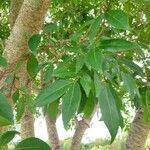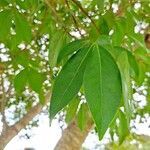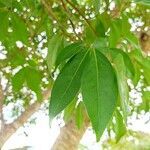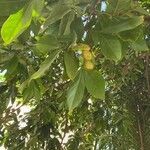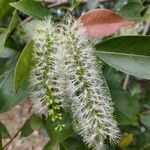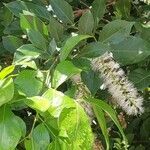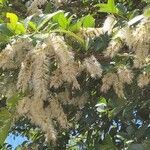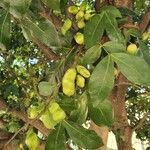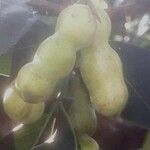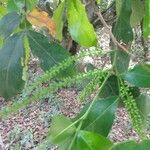Moderate-sized tree, the branchlets glabrous and markedly lenticellate. Leaves moderate-sized, usually 4-(or sometimes 6-, or reported occasionally 2-) foliolate; petiole 1-2 cm. long, terete except angled laterally above, glabrous; rachis 2-5 cm. long, glabrous, wingless but ridged and somewhat marginate laterally above, bear-ing a small, sessile, disc-like or subcupuliform gland between insertion of the pepiolules; leaflets usually 2 pairs, sometimes 3 or 1? pair, mostly oblong or elliptic, 4-12 cm. long and 1.5-5.5 cm. wide, usually acute and bluntly acuminate apically, cuneate and slightly inequilateral basally, glabrous above and below; stipules linear-oblong, up to 5 or 6 mm. long, pubescent, subpersistent or caducous. Inflorescence of 1 or 2 elongate spikes from each of a number of foliate or defoliate axils; spikes subglabrous, about 10 cm. long, the peduncular portion only about 2 cm. long, the many flowers scattered over the remaining floriferous portion. Flowers whitish, glabrous to puberulent; calyx cupuliform-tubular, 1-2 mm. long, the teeth minute but distinct; corolla usually 4-5 mm. long, narrowed basally, expanded apically, subglabrous; stamens 12-15 mm. long, fused basally into a tube greatly and notice-ably exceeding the corolla (Panama?) or only slightly exceeding the corolla. Legume reported flat and strongly compressed, 7-15 cm. long and 2-3.5 cm. wide, subglabrous, the margins thickened.
More
A tree. It grows 9-20 m tall. It has a low crown. The trunk is 50-70 cm across. The leaves are compound and have 2-3 pairs of leaflets. The end pair of leaflets are 6-13 cm long and the pair at the base are 3-8 cm long. The flowering groups are in the axils of leaves with 1-3 groups of flowers. The flower is like a short bottlebrush of white thread like stamens. The fruit is a curved pod 5-20 cm long. There are 5-15 seeds in a sweet aril.
Tree to c. 15 m high. Flowers in spikes, white. Pod brown, oblong flat, up to 15 by 3.5 cm, with the seeds embedded in a sugary pulp.
Moist lowland limestone areas. Wet to semi-dry forests, or highland savannas. Found in a variety of habitats from dry scrublands in some Caribbean islands to the rain forest or the wet cloudy forests of Central American highlands.
More
It is a tropical plant. It grows in moist, lowland limestone areas. It also grows in drier areas. It grows near rivers and the edges of forests. In Argentina it grows from sea level to 1,500 m above sea level.
